Perfect Temperatures for whole BBQ Chicken
Are you looking for an easy BBQ project for the weekend? Why not smoke a whole chicken? It’s a project that’s inexpensive and quick-cooking even with the low cooking temperatures of smoking. Temperature is a critical component to the perfect cook for tender, succulent BBQ chicken. We have the precision tools along with chicken cooking and doneness temps to set you up for smoky success!
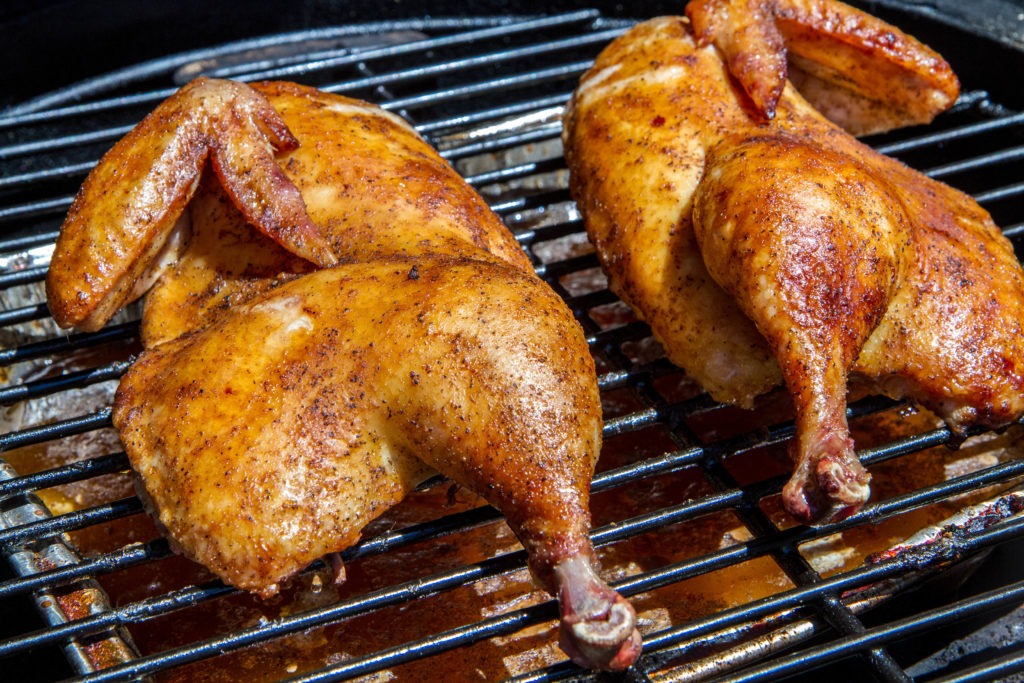
BBQ chicken pull temp: 157°F in the breast
Why BBQ a Whole Chicken Rather Than Roast It?
Chicken is a leaner meat than pork shoulder or brisket and may seem like an unlikely candidate for a low-temperature cook. Whole chickens are more commonly oven-roasted, so what is the benefit of smoking a whole chicken over roasting it in the oven? There are two benefits: 1) smoke flavor, and 2) a tender, silky texture.
1.Smoke
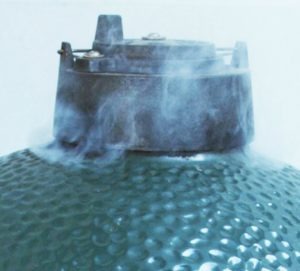
The complex flavors that smoke imparts to meat only happen with BBQ’s low cooking temperature. Higher cooking temperatures can cause the wood to combust, or produce smoke that can cause bitter or off-flavors to develop.
2. Texture: It’s All About Time and Temperature
Low-temperature cooking allows for slower heat transfer, giving collagen in the meat’s connective tissues the time needed to dissolve into silky gelatin (see our post on Smoked Pulled Pork for more information on the topic of breaking down connective tissues). The gelatin absorbs moisture, helping the meat retain moisture.
Q: Won’t the breast meat become dry with a long cook time?
A: The factor that determines the final texture of the meat is its internal temperature. Pulling the chicken from the smoker at the right temperature (allowing for carryover cooking to reach the final doneness temperature) will yield juicy results. Without temperature tracking, overcooking poultry beyond its pull and doneness temperatures is quite likely, and that’s when meat becomes dry.
Q: Will the skin be rubbery?
A: Brushing the chicken with melted butter and a mop sauce during the cook keeps the skin moist, and assists in keeping its texture at bite-through consistency. The key cooking and doneness temperatures for this BBQ chicken project are the secret to its success.
A Quick Low and Slow Cook
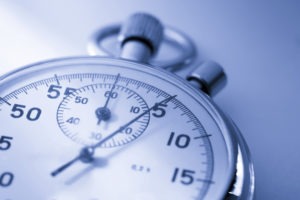
The cooking temperature range for barbecue is about 200-300°F (93-149°C). Normally, that means a long slow cooking process, but a whole chicken is a tender, leaner cut of meat than traditional BBQ cuts. This cook will take approximately 1-1/2 to 2 hours, depending on the size of the chicken and the maintained temperature of your cooker. Remember that the best way to determine the doneness of chicken is with temperature, not cooking time. Trust the accuracy of your temperature readings.
The most accurate way to assess the doneness of smoked foods is to check the internal temperature with an instant-read thermometer. Even the pros do it. Especially the pros do it. —Project Smoke, Steven Raichlen
Recommended Thermometers
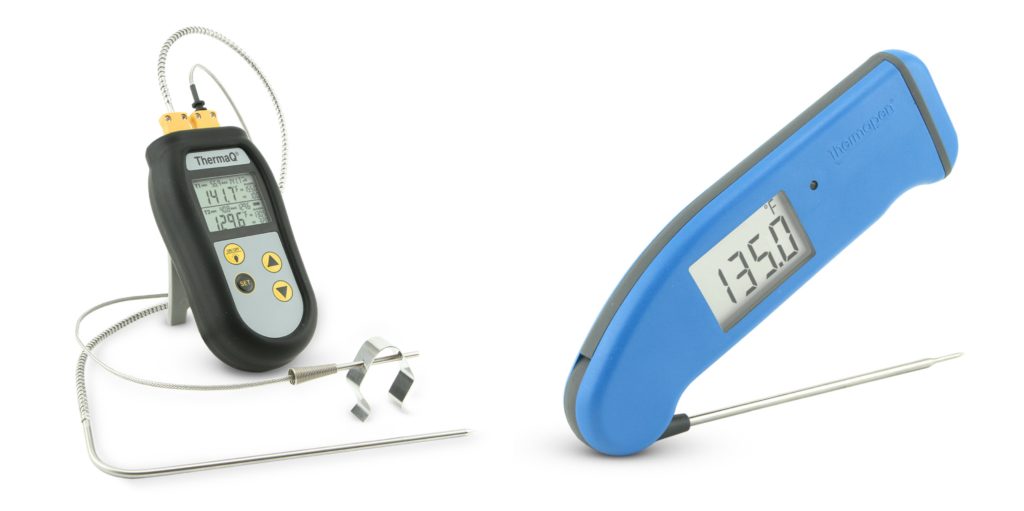
ThermaQ Thermapen
ThermaQ® is the perfect tool for any BBQ project! It’s a dual-channel thermometer with high and low alarms, and max and min recorded temps for each channel. You can keep your cooker’s temp in check while monitoring the meat’s cooking progress at the same time. Since the doneness of any meat is best measured through temperature than any other method, the ThermaQ along with an instant-read digital thermometer like the Thermapen® Mk4 are the best tools to get the job done.
Why Spot-Check?
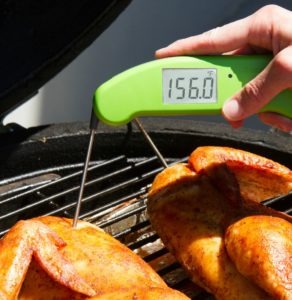
Why use a Thermapen in addition to the ThermaQ? When the alarm for the chicken’s high alarm sounds, it’s important to quickly spot-check the chicken’s internal temperature to verify that the reading is really the lowest temperature in the bird.
The meat’s thermal center may be slightly off from the ThermaQ probe’s initial placement. If you find a lower temperature just let the chicken cook a few minutes longer. Hooray for temperature! There’s no other way to achieve perfect, reliable results time after time.
Also, with the Thermapen’s super-fast® readings, you’ll only need to keep the cooker’s lid open for mere seconds to get an accurate reading. You won’t have worry about losing all your ambient heat and smoke.
BBQ Chicken Recipe
Ingredients
The components for the project are simple and few. No need to make a special trip to the grocery store to round up odd ingredients.
- 1 whole chicken, about 3-4 pounds
- Your favorite dry rub, or keep it simple with salt and pepper
- Wood chunks or chips, 2-4 ounces by weight (experts recommend using a bit less wood for chicken than you normally would with pork or beef)
- Melted butter for basting, about 1-2 sticks
- Mop sauce
- We used this simple mop sauce recipe from NibbleMeThis.com
Instructions
The Chicken
Splitting the chicken in half allows the meat to cook more uniformly than if it was left whole. To break down the chicken:

- Remove the backbone by cutting along both sides of the backbone with kitchen shears or a sharp chef’s knife.
- After the backbone is removed, you’ll be able to see the breastbone from the inside. Cut the chicken in half through the center of the breastbone with a sharp chef’s knife. Done!

- Watch the video at the top of this post to see exactly how to split the chicken into halves.
The Rub
- Apply the dry rub (or salt and pepper) evenly on all sides of the chicken, rubbing in slightly with your fingers.
- You can proceed directly with the cook now, or refrigerate the seasoned chicken overnight, uncovered.
- If held overnight, the rub will dry brine the meat, allowing the salt to dissolve and season the meat and slightly break down its protein to allow it to more readily retain its own juices.

Brining, whether a traditional water-based brine or a dry-brine, improves [poultry’s] ability to retain moisture. Certain muscle proteins are naturally dissolved by the salt in the brine solution. Once these proteins are dissolved, muscle fibers lose some of their ability to contract when cooking. Less contraction leads to less internal moisture being squeezed out, which in turn leads to juicier meat in the cooked bird.
—Kenji Lopez-Alt, Serious Eats
The Cooker
- Fire up your smoker—for our cook we used a Big Green Egg (see thermal tip below). Prepare your fuel (whether it’s charcoal, logs, or gas settings) to maintain the target ambient cooking temperature inside the smoker is 275°F (135°C).
☼ Thermal Tip: If you don’t have a smoker, set up your gas or charcoal grill for a two-zone fire, and use a wood chip packet to produce smoke. To learn more about how to set up a two-zone fire and cooking with indirect heat, read our post Indirect Heat: Grill-Roasted Sweet Stuffed Pork Loin.
- Set a water pan above the coals and below the grill grate to catch the chicken’s drippings (to avoid flare-ups), and help maintain a humid environment for better smoke penetration.
- Set grill grate in place in the smoker above the water pan.
- To avoid off flavors and possible flare-ups, be sure grate is clean.

- Secure the high temp air probe to the grill grate surface with a grate clip.
- On the ThermaQ, set the cooker channel’s high alarm to 300°F (149°C), and the low alarm to 250°F (121°C). Having both the high and low alarms will help you keep the ambient cooking temperature in check. Adjust the cooker’s vents or add fuel as necessary to maintain the proper cooking temperature.
- Add the wood and allow it to begin developing smoke with the lid closed for about 15 minutes prior to adding the meat.
Probe Placement
- Set the ThermaQ’s high alarm to 157°F (69°C) for the channel that will be tracking the temperature of the chicken as it cooks. This is the chicken’s pull temperature.
- Place the smokehouse penetration probe into the deepest part of the chicken breast, away from bone—this area will take the longest to reach your target internal pull temperature.
- The goal is to capture the lowest temperature in the meat. Your chicken is only as done, and as safe as the lowest temperature you find.

Get Cooking!
- Place the chicken halves on the grill grate surface.
- Baste with melted butter, close the lid, and set a TimeStick® for 20 minutes.
- Baste with butter again after the 20 minutes are up. Set the TimeStick for another 20 minutes.
☼ Thermal Tip: The smoke point of real butter is about 350°F (177°C)—the temperatures of smoking are well below this landmark. Don’t worry about the butter scorching during the cook.
- Brush the chicken with mop sauce. Brush again after another 20 minutes. After applying the mop sauce twice, you can just allow the chicken to continue to cook or mop again if you would like. It’s up to you.
- When the meat’s high alarm sounds, spot-check its internal temperature with a Thermapen. The internal temperature of the breast should be about 157°F (69°C), and the leg meat should be 170-175°F (77-79°C).

- Pull the chicken halves from the smoker and allow them to rest for 10-15 minutes. During the rest, the carryover cooking will increase the chicken’s temperature 5-10°F (3-6°C) for a final cooked temperature of 160-165°F (71-74°C).
☼ Thermal Tip: To learn more about safe pasteurization temperatures for cooked chicken, read our post, Thermal Tips: Simple Roasted Chicken.
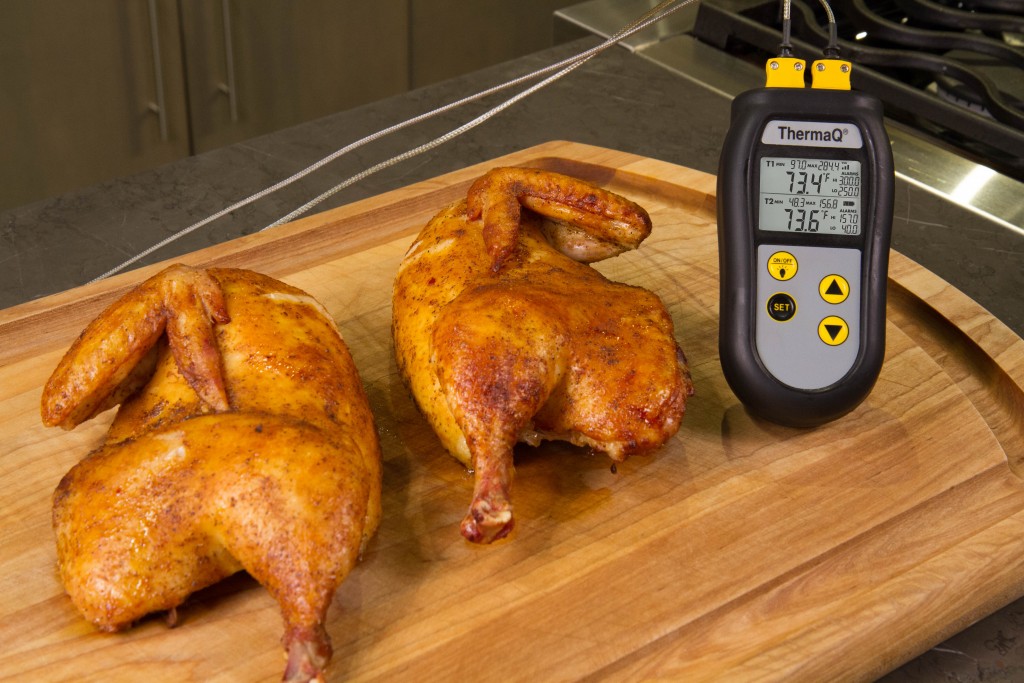
To Recap:
The key temps you need to know are:
Smoker Temperature: 275°F (135°C)
- Smoker High/Low Alarm Settings: 250°F/300°F (121°C/149°C)
- Chicken High Alarm Setting: 157°F (69°C)
- Chicken Pull Temperature: Breast—157°F (69°C), Leg—170-175°F (77-79°C)
- Chicken Final Doneness Temperature (after resting): 160-165°F (71-74°C)
Using a ThermaQ and Thermapen together really takes the guesswork out of any smoking project. Give this dynamic duo a try!
Products Used:
Resources:


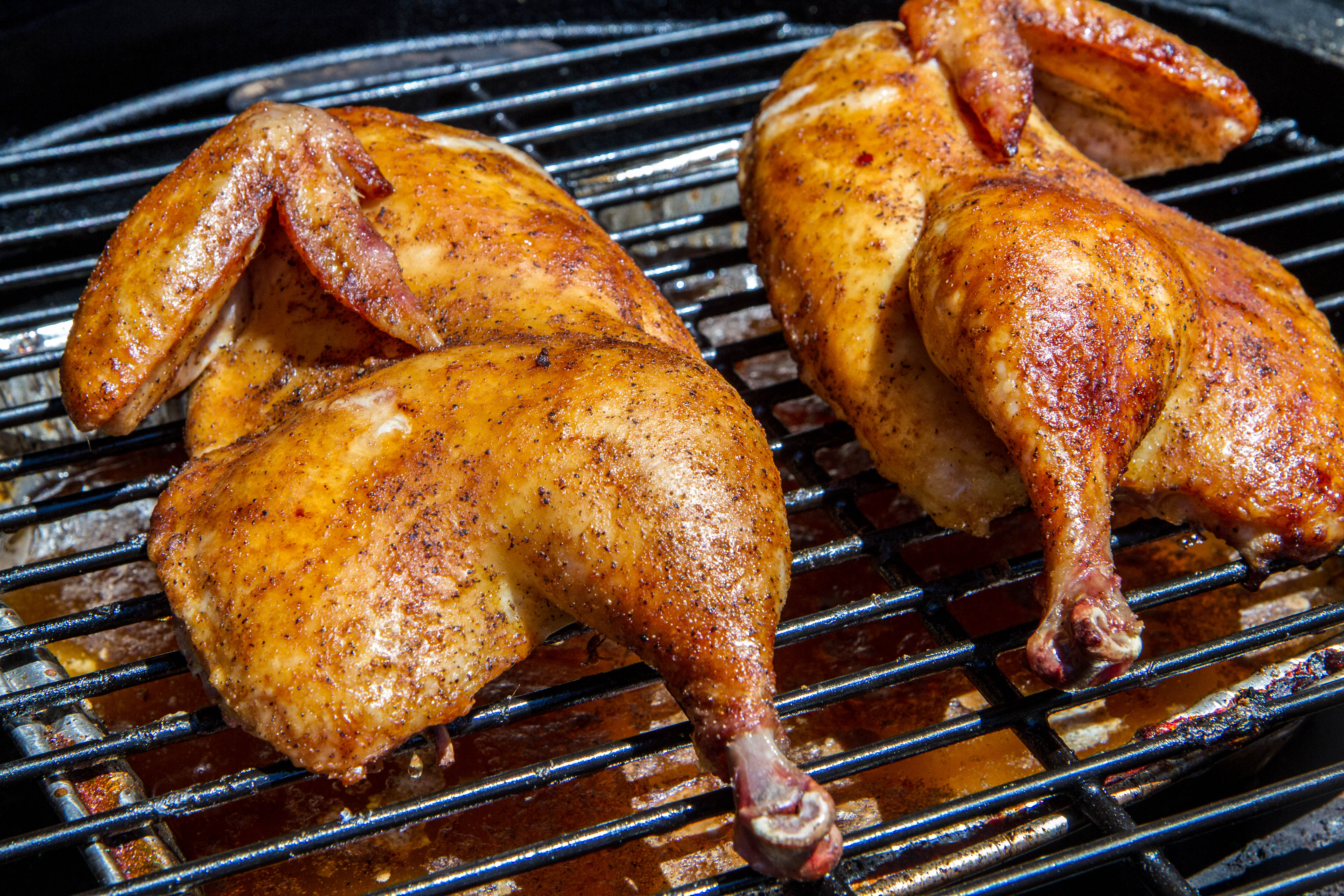
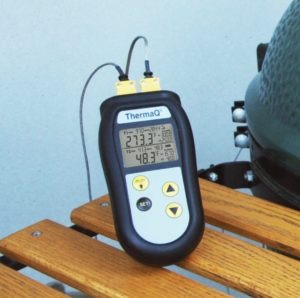 Smoker Temperature: 275°F (135°C)
Smoker Temperature: 275°F (135°C)
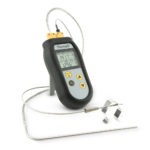
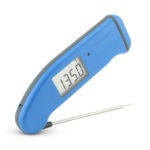
I love your simple yet detailed directions and the recap makes it so easy to follow and apply. I will be trying this split chicken recipe this evening on my BGE smoker! Hope it turns out as well as yours! Thanks again!
Christoph,
Glad you enjoyed the post! Smoked chicken is a personal favorite bbq project of mine for its simplicity. I can’t tell you how many of my family and friends have said it’s the best chicken they’ve ever had. Have fun with your cook!
Thanks for your comment!
-Kim
Let’s see. You title the article ” Perfect temperature for BBQ chicken”.
Yet never did I see where you told us the perfect done temperature. Which is the target you are striving for.
Dave,
I’m sorry that the temperatures weren’t more clear in the post. Please see the cooker temperature range (ambient temperature of the smoker as monitored with an air probe) set with the ThermaQ, the chicken’s pull temperature set on the ThermaQ, as well as the Recap at the bottom of the post. All of the cooker temps, meat pull temperatures (internal temperature to pull the meat from the smoker), and doneness temperatures (final temperature reached after resting) are listed. The temperatures are also called out in the video’s text.
Thanks!
-Kim